THE VALUE OF THE EVERYDAY IN LARRY MADRIGAL
VETA by Fer Francés presents the first solo exhibition of Larry Madrigal (Los Angeles, USA, 1986), one of the latest artists to join the list of those represented by the Madrid gallery. Too Good to be True presents about twenty portraits that revolve around the background of human relationships, interpersonal connection and intimacy, themes that the Mexican-American artist is considering after becoming a father and radically changing his interest in political art.
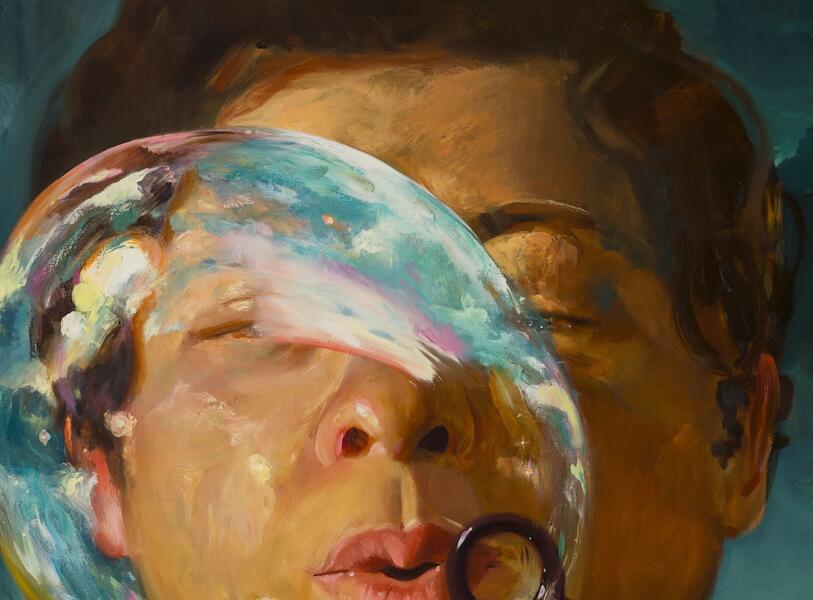
Thus, the exhibition takes us into an everyday, reflective and intimate plane, where the evolution of the human being from birth to maturity is the thematic nexus of Madrigal's portraits. In this way, the artist's work refers us to the importance of daily actions that, although small, can forge the character more than the great milestones, elevating the routine to an instrumental element of the personal environment.
However, Madrigal does not ignore the power of painting in terms of the introduction of complementary elements and his canvases show and incorporate objects and auras that take us to a dimension with certain surrealistic touches. Shines, shades or bubbles are the preferred tools to give that patina of surreal realism, closer to the former, despite the possible influence of pop surrealism, and which has become a personal mark of the artist.
-
Too Good to be True en VETA by Fer Francés
-
Too Good to be True en VETA by Fer Francés
-
Too good to be True en VETA by Fer Francés
-
Too good to be True en VETA by Fer Francés
-
Too good to be True en VETA by Fer Francés
-
Too good to be True en VETA by Fer Francés
-
Too good to be True en VETA by Fer Francés
Too Good to be True can be seen until February 14 at VETA by Fer Francés, Antoñita Jiménez, 21, Madrid (Spain).
May interest you
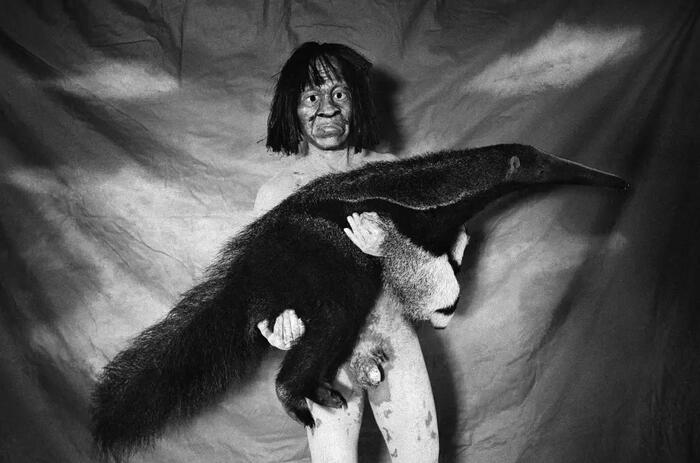
In its exhibition Páro Ques̈há, the Madrid-based MEMORIA presents a dialogue between Roldán Pinedo (Yarinacocha, Peru, 1971) and Javier Silva Meinel (Lima, Peru, 1949), works by both artists that present elements from the heart of the Peruvian Amazon and the Shipibo-Conibo cosmogony. In the imaginary of this Amazonian culture, the drawings receive spirit and life when they are embodied and connected to a further cosmic language. Thus, paintings, ceramics, textiles or instruments of various kinds are considered sacred and become receptacles of spirits whose task is to watch over those who possess them.

In its exhibition Páro Ques̈há, the Madrid-based MEMORIA presents a dialogue between Roldán Pinedo (Yarinacocha, Peru, 1971) and Javier Silva Meinel (Lima, Peru, 1949), works by both artists that present elements from the heart of the Peruvian Amazon and the Shipibo-Conibo cosmogony. In the imaginary of this Amazonian culture, the drawings receive spirit and life when they are embodied and connected to a further cosmic language. Thus, paintings, ceramics, textiles or instruments of various kinds are considered sacred and become receptacles of spirits whose task is to watch over those who possess them.
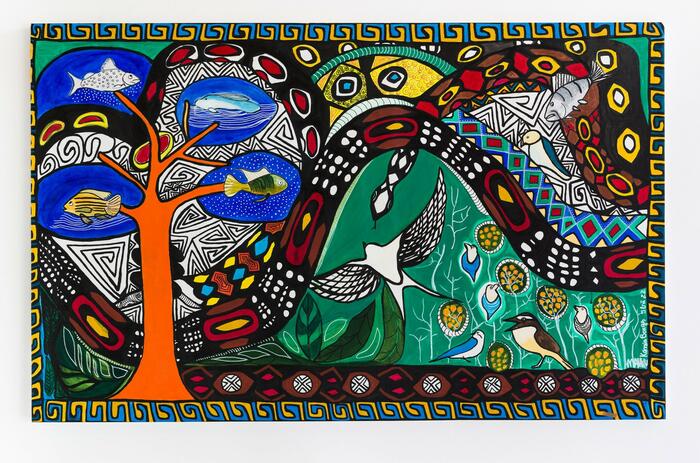
The CCCB (Center of Contemporary Culture of Barcelona) dedicates a wide, meticulous and interesting exhibition that takes us into the natural and cultural heritage of the Amazon, with special emphasis on the art and thought of the cities and indigenous communities of the region. Amazonia. The Ancestral Future brings to the table a detailed vision of artistic practices and Amazonian culture through the work of an extensive list of artists who produce around their thinking and relationship with nature.
A COMPLETE VISION TO THE CULTURAL AMAZON AT CCCB
The CCCB (Center of Contemporary Culture of Barcelona) dedicates a wide, meticulous and interesting exhibition that takes us into the natural and cultural heritage of the Amazon, with special emphasis on the art and thought of the cities and indigenous communities of the region. Amazonia. The Ancestral Future brings to the table a detailed vision of artistic practices and Amazonian culture through the work of an extensive list of artists who produce around their thinking and relationship with nature.
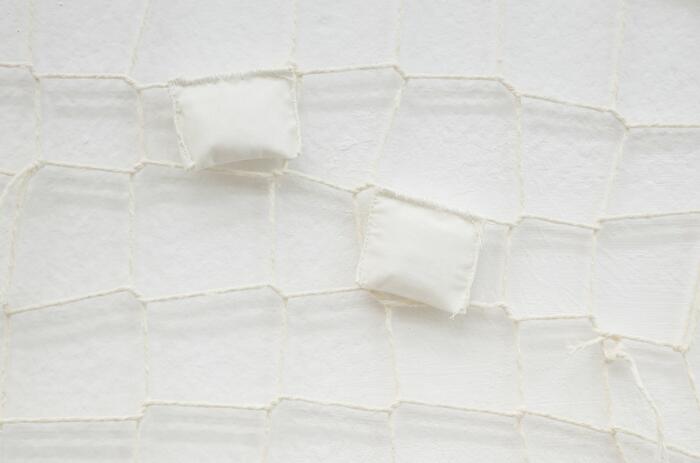
The Spanish gallery presents a group exhibition exploring the act of weaving as a practice that connects stories, heritages, and generations. Soltaré cien conejos y usted verá cómo le hace para juntarlos todos (I will release a hundred rabbits and you will see how you manage to collect them all) reflects on the intersections between the artisanal and the contemporary, addressing themes such as cultural identity, territorial dispossession, and collective memory.
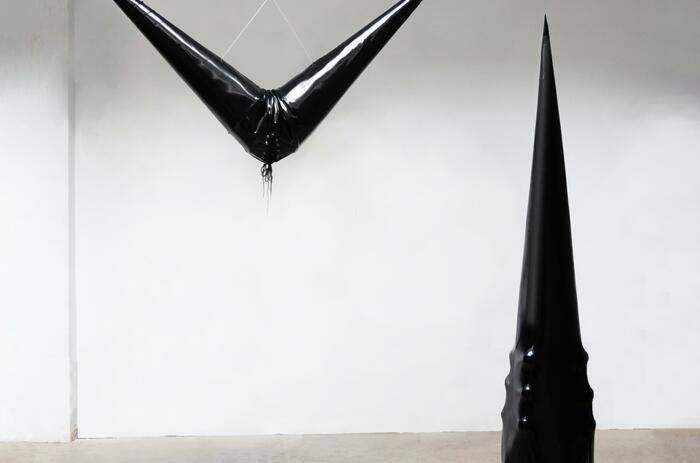
The result of the selection proposed to represent Circuitos de Artes Plásticas 2024, one of the main emerging art projects of the Community of Madrid, has had in this edition a Latin American protagonist in the curatorial work of Isabella Lenzi (São Paulo, Brazil, 1986). The show, named Caja de resonancia (Resonance Box) for the occasion, reviews, through the ten winning works of this annual call, some of the recurring themes and matrixes in the under-35 generation of artists linked to Madrid.
LENZI'S ON YOUNG ART IN MADRID
The result of the selection proposed to represent Circuitos de Artes Plásticas 2024, one of the main emerging art projects of the Community of Madrid, has had in this edition a Latin American protagonist in the curatorial work of Isabella Lenzi (São Paulo, Brazil, 1986). The show, named Caja de resonancia (Resonance Box) for the occasion, reviews, through the ten winning works of this annual call, some of the recurring themes and matrixes in the under-35 generation of artists linked to Madrid.
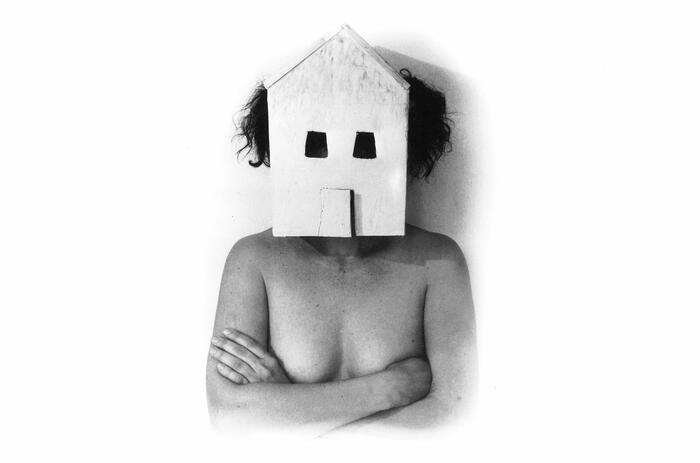
The incipient collection of MARCO of Vigo -under construction, but with enough funds to delimit its influence and incidence-, makes its debut in the delimitation of its radius of action with the first exhibition built exclusively with its own funds. For the occasion, the outline that unites Una imagen de sí builds on the general idea that will guide the near future: that Galician art dialogues with the outside world, mainly Latin America, and draws a relational history.
PÉREZ BRAVO IN DIALOGUE IN THE MARCO COLLECTION
The incipient collection of MARCO of Vigo -under construction, but with enough funds to delimit its influence and incidence-, makes its debut in the delimitation of its radius of action with the first exhibition built exclusively with its own funds. For the occasion, the outline that unites Una imagen de sí builds on the general idea that will guide the near future: that Galician art dialogues with the outside world, mainly Latin America, and draws a relational history.

Under the enlightening title of Los espacios del pánico (Estudios superficiales sobre el vacío y el color) (The spaces of panic-Surface studies on emptiness and color), the interesting individual exhibition that the Madrid gallery El Apartamento dedicates to Luis Enrique Lopez-Chavez (Manzanillo, Cuba, 1988) is developed as a thesis scenario for the almost scientific analysis that the Cuban artist has developed around the space of the void and the chromatic.
EMPTINESS AND COLOR IN LÓPEZ-CHÁVEZ
Under the enlightening title of Los espacios del pánico (Estudios superficiales sobre el vacío y el color) (The spaces of panic-Surface studies on emptiness and color), the interesting individual exhibition that the Madrid gallery El Apartamento dedicates to Luis Enrique Lopez-Chavez (Manzanillo, Cuba, 1988) is developed as a thesis scenario for the almost scientific analysis that the Cuban artist has developed around the space of the void and the chromatic.

Gabriel O'Shea (Metepec, Mexico, 1998) manages to delve into that huge and apparent dichotomy between the technological and the human (or the future and the real) in his most recent proposal at Hilario Galguera's Madrid headquarters, a series of paintings of high conceptual content that critically debate on several technical and thinking aspects.
GABRIEL O'SHEA'S HUMAN AND REALISTIC TECHNOLOGICAL FUTURE
Gabriel O'Shea (Metepec, Mexico, 1998) manages to delve into that huge and apparent dichotomy between the technological and the human (or the future and the real) in his most recent proposal at Hilario Galguera's Madrid headquarters, a series of paintings of high conceptual content that critically debate on several technical and thinking aspects.
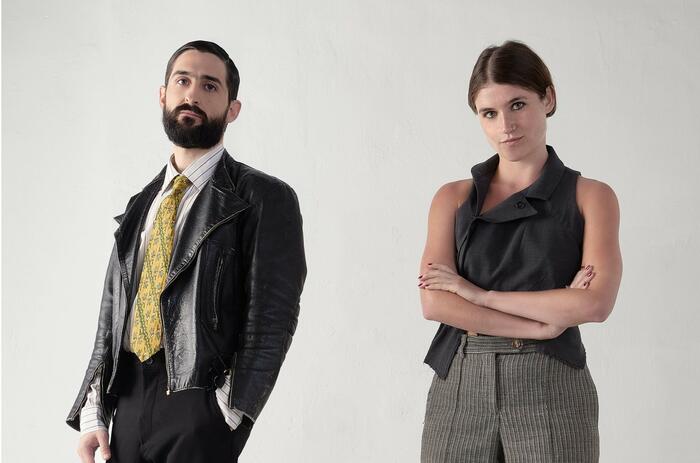
The curatorial duo Carmen Lael Hines and Roberto Majano will be the new Head Curators at The RYDER Projects. This represents a new stage in the gallery that succeeds the period led by Rafa Barber, who has held this position heretofore.
THE RYDER PROJECTS ANNOUNCED NEW CURATORS
The curatorial duo Carmen Lael Hines and Roberto Majano will be the new Head Curators at The RYDER Projects. This represents a new stage in the gallery that succeeds the period led by Rafa Barber, who has held this position heretofore.

In its exhibition Páro Ques̈há, the Madrid-based MEMORIA presents a dialogue between Roldán Pinedo (Yarinacocha, Peru, 1971) and Javier Silva Meinel (Lima, Peru, 1949), works by both artists that present elements from the heart of the Peruvian Amazon and the Shipibo-Conibo cosmogony. In the imaginary of this Amazonian culture, the drawings receive spirit and life when they are embodied and connected to a further cosmic language. Thus, paintings, ceramics, textiles or instruments of various kinds are considered sacred and become receptacles of spirits whose task is to watch over those who possess them.

The CCCB (Center of Contemporary Culture of Barcelona) dedicates a wide, meticulous and interesting exhibition that takes us into the natural and cultural heritage of the Amazon, with special emphasis on the art and thought of the cities and indigenous communities of the region. Amazonia. The Ancestral Future brings to the table a detailed vision of artistic practices and Amazonian culture through the work of an extensive list of artists who produce around their thinking and relationship with nature.
A COMPLETE VISION TO THE CULTURAL AMAZON AT CCCB
The CCCB (Center of Contemporary Culture of Barcelona) dedicates a wide, meticulous and interesting exhibition that takes us into the natural and cultural heritage of the Amazon, with special emphasis on the art and thought of the cities and indigenous communities of the region. Amazonia. The Ancestral Future brings to the table a detailed vision of artistic practices and Amazonian culture through the work of an extensive list of artists who produce around their thinking and relationship with nature.

The Spanish gallery presents a group exhibition exploring the act of weaving as a practice that connects stories, heritages, and generations. Soltaré cien conejos y usted verá cómo le hace para juntarlos todos (I will release a hundred rabbits and you will see how you manage to collect them all) reflects on the intersections between the artisanal and the contemporary, addressing themes such as cultural identity, territorial dispossession, and collective memory.

The result of the selection proposed to represent Circuitos de Artes Plásticas 2024, one of the main emerging art projects of the Community of Madrid, has had in this edition a Latin American protagonist in the curatorial work of Isabella Lenzi (São Paulo, Brazil, 1986). The show, named Caja de resonancia (Resonance Box) for the occasion, reviews, through the ten winning works of this annual call, some of the recurring themes and matrixes in the under-35 generation of artists linked to Madrid.
LENZI'S ON YOUNG ART IN MADRID
The result of the selection proposed to represent Circuitos de Artes Plásticas 2024, one of the main emerging art projects of the Community of Madrid, has had in this edition a Latin American protagonist in the curatorial work of Isabella Lenzi (São Paulo, Brazil, 1986). The show, named Caja de resonancia (Resonance Box) for the occasion, reviews, through the ten winning works of this annual call, some of the recurring themes and matrixes in the under-35 generation of artists linked to Madrid.

The incipient collection of MARCO of Vigo -under construction, but with enough funds to delimit its influence and incidence-, makes its debut in the delimitation of its radius of action with the first exhibition built exclusively with its own funds. For the occasion, the outline that unites Una imagen de sí builds on the general idea that will guide the near future: that Galician art dialogues with the outside world, mainly Latin America, and draws a relational history.
PÉREZ BRAVO IN DIALOGUE IN THE MARCO COLLECTION
The incipient collection of MARCO of Vigo -under construction, but with enough funds to delimit its influence and incidence-, makes its debut in the delimitation of its radius of action with the first exhibition built exclusively with its own funds. For the occasion, the outline that unites Una imagen de sí builds on the general idea that will guide the near future: that Galician art dialogues with the outside world, mainly Latin America, and draws a relational history.

Under the enlightening title of Los espacios del pánico (Estudios superficiales sobre el vacío y el color) (The spaces of panic-Surface studies on emptiness and color), the interesting individual exhibition that the Madrid gallery El Apartamento dedicates to Luis Enrique Lopez-Chavez (Manzanillo, Cuba, 1988) is developed as a thesis scenario for the almost scientific analysis that the Cuban artist has developed around the space of the void and the chromatic.
EMPTINESS AND COLOR IN LÓPEZ-CHÁVEZ
Under the enlightening title of Los espacios del pánico (Estudios superficiales sobre el vacío y el color) (The spaces of panic-Surface studies on emptiness and color), the interesting individual exhibition that the Madrid gallery El Apartamento dedicates to Luis Enrique Lopez-Chavez (Manzanillo, Cuba, 1988) is developed as a thesis scenario for the almost scientific analysis that the Cuban artist has developed around the space of the void and the chromatic.

Gabriel O'Shea (Metepec, Mexico, 1998) manages to delve into that huge and apparent dichotomy between the technological and the human (or the future and the real) in his most recent proposal at Hilario Galguera's Madrid headquarters, a series of paintings of high conceptual content that critically debate on several technical and thinking aspects.
GABRIEL O'SHEA'S HUMAN AND REALISTIC TECHNOLOGICAL FUTURE
Gabriel O'Shea (Metepec, Mexico, 1998) manages to delve into that huge and apparent dichotomy between the technological and the human (or the future and the real) in his most recent proposal at Hilario Galguera's Madrid headquarters, a series of paintings of high conceptual content that critically debate on several technical and thinking aspects.

The curatorial duo Carmen Lael Hines and Roberto Majano will be the new Head Curators at The RYDER Projects. This represents a new stage in the gallery that succeeds the period led by Rafa Barber, who has held this position heretofore.
THE RYDER PROJECTS ANNOUNCED NEW CURATORS
The curatorial duo Carmen Lael Hines and Roberto Majano will be the new Head Curators at The RYDER Projects. This represents a new stage in the gallery that succeeds the period led by Rafa Barber, who has held this position heretofore.

In its exhibition Páro Ques̈há, the Madrid-based MEMORIA presents a dialogue between Roldán Pinedo (Yarinacocha, Peru, 1971) and Javier Silva Meinel (Lima, Peru, 1949), works by both artists that present elements from the heart of the Peruvian Amazon and the Shipibo-Conibo cosmogony. In the imaginary of this Amazonian culture, the drawings receive spirit and life when they are embodied and connected to a further cosmic language. Thus, paintings, ceramics, textiles or instruments of various kinds are considered sacred and become receptacles of spirits whose task is to watch over those who possess them.

The CCCB (Center of Contemporary Culture of Barcelona) dedicates a wide, meticulous and interesting exhibition that takes us into the natural and cultural heritage of the Amazon, with special emphasis on the art and thought of the cities and indigenous communities of the region. Amazonia. The Ancestral Future brings to the table a detailed vision of artistic practices and Amazonian culture through the work of an extensive list of artists who produce around their thinking and relationship with nature.
A COMPLETE VISION TO THE CULTURAL AMAZON AT CCCB
The CCCB (Center of Contemporary Culture of Barcelona) dedicates a wide, meticulous and interesting exhibition that takes us into the natural and cultural heritage of the Amazon, with special emphasis on the art and thought of the cities and indigenous communities of the region. Amazonia. The Ancestral Future brings to the table a detailed vision of artistic practices and Amazonian culture through the work of an extensive list of artists who produce around their thinking and relationship with nature.

The Spanish gallery presents a group exhibition exploring the act of weaving as a practice that connects stories, heritages, and generations. Soltaré cien conejos y usted verá cómo le hace para juntarlos todos (I will release a hundred rabbits and you will see how you manage to collect them all) reflects on the intersections between the artisanal and the contemporary, addressing themes such as cultural identity, territorial dispossession, and collective memory.

The result of the selection proposed to represent Circuitos de Artes Plásticas 2024, one of the main emerging art projects of the Community of Madrid, has had in this edition a Latin American protagonist in the curatorial work of Isabella Lenzi (São Paulo, Brazil, 1986). The show, named Caja de resonancia (Resonance Box) for the occasion, reviews, through the ten winning works of this annual call, some of the recurring themes and matrixes in the under-35 generation of artists linked to Madrid.
LENZI'S ON YOUNG ART IN MADRID
The result of the selection proposed to represent Circuitos de Artes Plásticas 2024, one of the main emerging art projects of the Community of Madrid, has had in this edition a Latin American protagonist in the curatorial work of Isabella Lenzi (São Paulo, Brazil, 1986). The show, named Caja de resonancia (Resonance Box) for the occasion, reviews, through the ten winning works of this annual call, some of the recurring themes and matrixes in the under-35 generation of artists linked to Madrid.

The incipient collection of MARCO of Vigo -under construction, but with enough funds to delimit its influence and incidence-, makes its debut in the delimitation of its radius of action with the first exhibition built exclusively with its own funds. For the occasion, the outline that unites Una imagen de sí builds on the general idea that will guide the near future: that Galician art dialogues with the outside world, mainly Latin America, and draws a relational history.
PÉREZ BRAVO IN DIALOGUE IN THE MARCO COLLECTION
The incipient collection of MARCO of Vigo -under construction, but with enough funds to delimit its influence and incidence-, makes its debut in the delimitation of its radius of action with the first exhibition built exclusively with its own funds. For the occasion, the outline that unites Una imagen de sí builds on the general idea that will guide the near future: that Galician art dialogues with the outside world, mainly Latin America, and draws a relational history.

Under the enlightening title of Los espacios del pánico (Estudios superficiales sobre el vacío y el color) (The spaces of panic-Surface studies on emptiness and color), the interesting individual exhibition that the Madrid gallery El Apartamento dedicates to Luis Enrique Lopez-Chavez (Manzanillo, Cuba, 1988) is developed as a thesis scenario for the almost scientific analysis that the Cuban artist has developed around the space of the void and the chromatic.
EMPTINESS AND COLOR IN LÓPEZ-CHÁVEZ
Under the enlightening title of Los espacios del pánico (Estudios superficiales sobre el vacío y el color) (The spaces of panic-Surface studies on emptiness and color), the interesting individual exhibition that the Madrid gallery El Apartamento dedicates to Luis Enrique Lopez-Chavez (Manzanillo, Cuba, 1988) is developed as a thesis scenario for the almost scientific analysis that the Cuban artist has developed around the space of the void and the chromatic.

Gabriel O'Shea (Metepec, Mexico, 1998) manages to delve into that huge and apparent dichotomy between the technological and the human (or the future and the real) in his most recent proposal at Hilario Galguera's Madrid headquarters, a series of paintings of high conceptual content that critically debate on several technical and thinking aspects.
GABRIEL O'SHEA'S HUMAN AND REALISTIC TECHNOLOGICAL FUTURE
Gabriel O'Shea (Metepec, Mexico, 1998) manages to delve into that huge and apparent dichotomy between the technological and the human (or the future and the real) in his most recent proposal at Hilario Galguera's Madrid headquarters, a series of paintings of high conceptual content that critically debate on several technical and thinking aspects.

The curatorial duo Carmen Lael Hines and Roberto Majano will be the new Head Curators at The RYDER Projects. This represents a new stage in the gallery that succeeds the period led by Rafa Barber, who has held this position heretofore.
THE RYDER PROJECTS ANNOUNCED NEW CURATORS
The curatorial duo Carmen Lael Hines and Roberto Majano will be the new Head Curators at The RYDER Projects. This represents a new stage in the gallery that succeeds the period led by Rafa Barber, who has held this position heretofore.

In its exhibition Páro Ques̈há, the Madrid-based MEMORIA presents a dialogue between Roldán Pinedo (Yarinacocha, Peru, 1971) and Javier Silva Meinel (Lima, Peru, 1949), works by both artists that present elements from the heart of the Peruvian Amazon and the Shipibo-Conibo cosmogony. In the imaginary of this Amazonian culture, the drawings receive spirit and life when they are embodied and connected to a further cosmic language. Thus, paintings, ceramics, textiles or instruments of various kinds are considered sacred and become receptacles of spirits whose task is to watch over those who possess them.

The CCCB (Center of Contemporary Culture of Barcelona) dedicates a wide, meticulous and interesting exhibition that takes us into the natural and cultural heritage of the Amazon, with special emphasis on the art and thought of the cities and indigenous communities of the region. Amazonia. The Ancestral Future brings to the table a detailed vision of artistic practices and Amazonian culture through the work of an extensive list of artists who produce around their thinking and relationship with nature.
A COMPLETE VISION TO THE CULTURAL AMAZON AT CCCB
The CCCB (Center of Contemporary Culture of Barcelona) dedicates a wide, meticulous and interesting exhibition that takes us into the natural and cultural heritage of the Amazon, with special emphasis on the art and thought of the cities and indigenous communities of the region. Amazonia. The Ancestral Future brings to the table a detailed vision of artistic practices and Amazonian culture through the work of an extensive list of artists who produce around their thinking and relationship with nature.

The Spanish gallery presents a group exhibition exploring the act of weaving as a practice that connects stories, heritages, and generations. Soltaré cien conejos y usted verá cómo le hace para juntarlos todos (I will release a hundred rabbits and you will see how you manage to collect them all) reflects on the intersections between the artisanal and the contemporary, addressing themes such as cultural identity, territorial dispossession, and collective memory.

The result of the selection proposed to represent Circuitos de Artes Plásticas 2024, one of the main emerging art projects of the Community of Madrid, has had in this edition a Latin American protagonist in the curatorial work of Isabella Lenzi (São Paulo, Brazil, 1986). The show, named Caja de resonancia (Resonance Box) for the occasion, reviews, through the ten winning works of this annual call, some of the recurring themes and matrixes in the under-35 generation of artists linked to Madrid.
LENZI'S ON YOUNG ART IN MADRID
The result of the selection proposed to represent Circuitos de Artes Plásticas 2024, one of the main emerging art projects of the Community of Madrid, has had in this edition a Latin American protagonist in the curatorial work of Isabella Lenzi (São Paulo, Brazil, 1986). The show, named Caja de resonancia (Resonance Box) for the occasion, reviews, through the ten winning works of this annual call, some of the recurring themes and matrixes in the under-35 generation of artists linked to Madrid.

The incipient collection of MARCO of Vigo -under construction, but with enough funds to delimit its influence and incidence-, makes its debut in the delimitation of its radius of action with the first exhibition built exclusively with its own funds. For the occasion, the outline that unites Una imagen de sí builds on the general idea that will guide the near future: that Galician art dialogues with the outside world, mainly Latin America, and draws a relational history.
PÉREZ BRAVO IN DIALOGUE IN THE MARCO COLLECTION
The incipient collection of MARCO of Vigo -under construction, but with enough funds to delimit its influence and incidence-, makes its debut in the delimitation of its radius of action with the first exhibition built exclusively with its own funds. For the occasion, the outline that unites Una imagen de sí builds on the general idea that will guide the near future: that Galician art dialogues with the outside world, mainly Latin America, and draws a relational history.

Under the enlightening title of Los espacios del pánico (Estudios superficiales sobre el vacío y el color) (The spaces of panic-Surface studies on emptiness and color), the interesting individual exhibition that the Madrid gallery El Apartamento dedicates to Luis Enrique Lopez-Chavez (Manzanillo, Cuba, 1988) is developed as a thesis scenario for the almost scientific analysis that the Cuban artist has developed around the space of the void and the chromatic.
EMPTINESS AND COLOR IN LÓPEZ-CHÁVEZ
Under the enlightening title of Los espacios del pánico (Estudios superficiales sobre el vacío y el color) (The spaces of panic-Surface studies on emptiness and color), the interesting individual exhibition that the Madrid gallery El Apartamento dedicates to Luis Enrique Lopez-Chavez (Manzanillo, Cuba, 1988) is developed as a thesis scenario for the almost scientific analysis that the Cuban artist has developed around the space of the void and the chromatic.

Gabriel O'Shea (Metepec, Mexico, 1998) manages to delve into that huge and apparent dichotomy between the technological and the human (or the future and the real) in his most recent proposal at Hilario Galguera's Madrid headquarters, a series of paintings of high conceptual content that critically debate on several technical and thinking aspects.
GABRIEL O'SHEA'S HUMAN AND REALISTIC TECHNOLOGICAL FUTURE
Gabriel O'Shea (Metepec, Mexico, 1998) manages to delve into that huge and apparent dichotomy between the technological and the human (or the future and the real) in his most recent proposal at Hilario Galguera's Madrid headquarters, a series of paintings of high conceptual content that critically debate on several technical and thinking aspects.

The curatorial duo Carmen Lael Hines and Roberto Majano will be the new Head Curators at The RYDER Projects. This represents a new stage in the gallery that succeeds the period led by Rafa Barber, who has held this position heretofore.
THE RYDER PROJECTS ANNOUNCED NEW CURATORS
The curatorial duo Carmen Lael Hines and Roberto Majano will be the new Head Curators at The RYDER Projects. This represents a new stage in the gallery that succeeds the period led by Rafa Barber, who has held this position heretofore.

In its exhibition Páro Ques̈há, the Madrid-based MEMORIA presents a dialogue between Roldán Pinedo (Yarinacocha, Peru, 1971) and Javier Silva Meinel (Lima, Peru, 1949), works by both artists that present elements from the heart of the Peruvian Amazon and the Shipibo-Conibo cosmogony. In the imaginary of this Amazonian culture, the drawings receive spirit and life when they are embodied and connected to a further cosmic language. Thus, paintings, ceramics, textiles or instruments of various kinds are considered sacred and become receptacles of spirits whose task is to watch over those who possess them.

The CCCB (Center of Contemporary Culture of Barcelona) dedicates a wide, meticulous and interesting exhibition that takes us into the natural and cultural heritage of the Amazon, with special emphasis on the art and thought of the cities and indigenous communities of the region. Amazonia. The Ancestral Future brings to the table a detailed vision of artistic practices and Amazonian culture through the work of an extensive list of artists who produce around their thinking and relationship with nature.
A COMPLETE VISION TO THE CULTURAL AMAZON AT CCCB
The CCCB (Center of Contemporary Culture of Barcelona) dedicates a wide, meticulous and interesting exhibition that takes us into the natural and cultural heritage of the Amazon, with special emphasis on the art and thought of the cities and indigenous communities of the region. Amazonia. The Ancestral Future brings to the table a detailed vision of artistic practices and Amazonian culture through the work of an extensive list of artists who produce around their thinking and relationship with nature.

The Spanish gallery presents a group exhibition exploring the act of weaving as a practice that connects stories, heritages, and generations. Soltaré cien conejos y usted verá cómo le hace para juntarlos todos (I will release a hundred rabbits and you will see how you manage to collect them all) reflects on the intersections between the artisanal and the contemporary, addressing themes such as cultural identity, territorial dispossession, and collective memory.

The result of the selection proposed to represent Circuitos de Artes Plásticas 2024, one of the main emerging art projects of the Community of Madrid, has had in this edition a Latin American protagonist in the curatorial work of Isabella Lenzi (São Paulo, Brazil, 1986). The show, named Caja de resonancia (Resonance Box) for the occasion, reviews, through the ten winning works of this annual call, some of the recurring themes and matrixes in the under-35 generation of artists linked to Madrid.
LENZI'S ON YOUNG ART IN MADRID
The result of the selection proposed to represent Circuitos de Artes Plásticas 2024, one of the main emerging art projects of the Community of Madrid, has had in this edition a Latin American protagonist in the curatorial work of Isabella Lenzi (São Paulo, Brazil, 1986). The show, named Caja de resonancia (Resonance Box) for the occasion, reviews, through the ten winning works of this annual call, some of the recurring themes and matrixes in the under-35 generation of artists linked to Madrid.

The incipient collection of MARCO of Vigo -under construction, but with enough funds to delimit its influence and incidence-, makes its debut in the delimitation of its radius of action with the first exhibition built exclusively with its own funds. For the occasion, the outline that unites Una imagen de sí builds on the general idea that will guide the near future: that Galician art dialogues with the outside world, mainly Latin America, and draws a relational history.
PÉREZ BRAVO IN DIALOGUE IN THE MARCO COLLECTION
The incipient collection of MARCO of Vigo -under construction, but with enough funds to delimit its influence and incidence-, makes its debut in the delimitation of its radius of action with the first exhibition built exclusively with its own funds. For the occasion, the outline that unites Una imagen de sí builds on the general idea that will guide the near future: that Galician art dialogues with the outside world, mainly Latin America, and draws a relational history.

Under the enlightening title of Los espacios del pánico (Estudios superficiales sobre el vacío y el color) (The spaces of panic-Surface studies on emptiness and color), the interesting individual exhibition that the Madrid gallery El Apartamento dedicates to Luis Enrique Lopez-Chavez (Manzanillo, Cuba, 1988) is developed as a thesis scenario for the almost scientific analysis that the Cuban artist has developed around the space of the void and the chromatic.
EMPTINESS AND COLOR IN LÓPEZ-CHÁVEZ
Under the enlightening title of Los espacios del pánico (Estudios superficiales sobre el vacío y el color) (The spaces of panic-Surface studies on emptiness and color), the interesting individual exhibition that the Madrid gallery El Apartamento dedicates to Luis Enrique Lopez-Chavez (Manzanillo, Cuba, 1988) is developed as a thesis scenario for the almost scientific analysis that the Cuban artist has developed around the space of the void and the chromatic.

Gabriel O'Shea (Metepec, Mexico, 1998) manages to delve into that huge and apparent dichotomy between the technological and the human (or the future and the real) in his most recent proposal at Hilario Galguera's Madrid headquarters, a series of paintings of high conceptual content that critically debate on several technical and thinking aspects.
GABRIEL O'SHEA'S HUMAN AND REALISTIC TECHNOLOGICAL FUTURE
Gabriel O'Shea (Metepec, Mexico, 1998) manages to delve into that huge and apparent dichotomy between the technological and the human (or the future and the real) in his most recent proposal at Hilario Galguera's Madrid headquarters, a series of paintings of high conceptual content that critically debate on several technical and thinking aspects.

The curatorial duo Carmen Lael Hines and Roberto Majano will be the new Head Curators at The RYDER Projects. This represents a new stage in the gallery that succeeds the period led by Rafa Barber, who has held this position heretofore.
THE RYDER PROJECTS ANNOUNCED NEW CURATORS
The curatorial duo Carmen Lael Hines and Roberto Majano will be the new Head Curators at The RYDER Projects. This represents a new stage in the gallery that succeeds the period led by Rafa Barber, who has held this position heretofore.




